Salesforce Education is transforming how institutions manage the student journey—from recruitment and admissions to alumni engagement. With powerful tools for data integration, personalized communication, and real-time analytics, it helps universities deliver a connected, student-centered experience.
Table Of Contents
- 1What Is the Salesforce Education Cloud Platform?
- 2Key Features of Salesforce Education Cloud
- 3Benefits of Using Salesforce Education Cloud in Higher Education
- 4Challenges in Implementing Salesforce Education Cloud
- 5Real-World Applications of Salesforce Education Cloud
- 6Top Salesforce Integrations for Higher Education Institutions
- 7Salesforce Education Cloud Pricing Tiers
- 8Key Cost Considerations for Salesforce Education Cloud Implementation
- 9Key Points to Consider When Choosing Salesforce for Education
- 10Top Salesforce Education Apps to Improve Campus Operations
- 11Overcoming Challenges in Salesforce CRM Implementation
- 12Conclusion
As universities strive to improve student retention, boost enrollment, and enhance fundraising, many are adopting Salesforce Education Cloud to streamline operations and personalize engagement.
Research by Forrester shows that institutions using Salesforce report a 15% increase in first-year retention, a 10% rise in fundraising, and a 5.5% boost in enrollment.
In this blog, we’ll explore how Salesforce supports student success, enhances engagement, and accelerates institutional performance.
What Is the Salesforce Education Cloud Platform?
Salesforce Education Cloud is a customer relationship management (CRM) solution tailored specifically for educational institutions. It consolidates data from prospective students, current learners, faculty, and alumni into a single, centralized system. Built on an education-specific data model, the platform enables institutions to design and deploy applications that support the full student lifecycle. By streamlining operations and improving engagement across departments, Salesforce Education Cloud helps schools, colleges, and universities better serve their diverse stakeholders.
Key Features of Salesforce Education Cloud
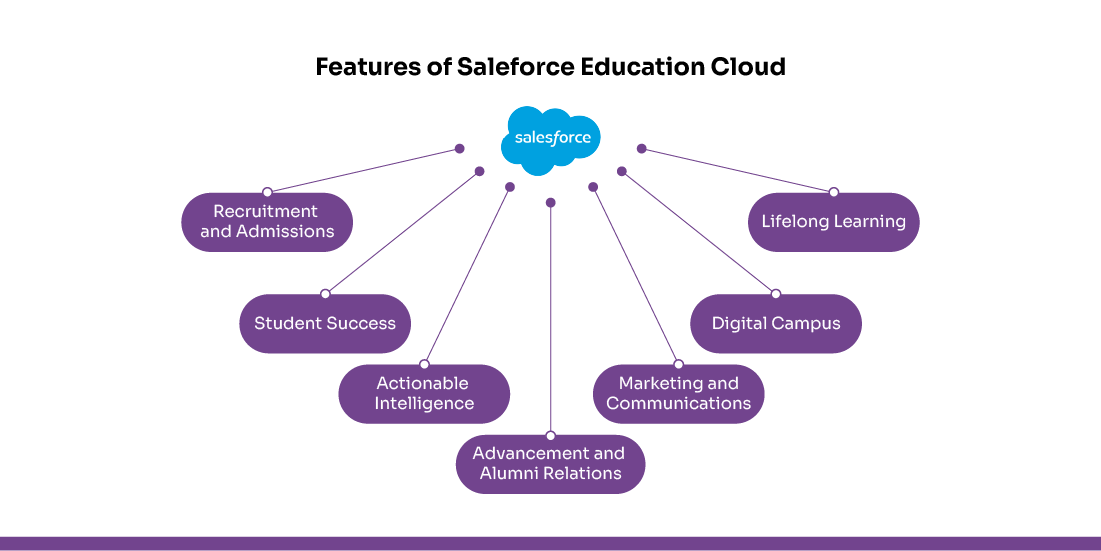
Salesforce provides powerful tools designed to simplify processes and boost engagement across the education system.
Streamlined Recruitment and Admissions
Salesforce streamlines recruitment by enabling institutions to build strong relationships with prospective students from the start. It automates personalized outreach using targeted email campaigns based on student interests. The platform offers full visibility into the applicant journey—from initial inquiry to enrollment. According to Educause, CRM implementation can lead to a 20% improvement in student retention and greater enrollment efficiency.
Student Success: A 360° View of Academic and Engagement Progress
Salesforce enhances student success by offering a holistic view of each learner’s academic progress, engagement, and support needs. Institutions can identify at-risk students early using real-time alerts and provide tailored interventions. Modern scheduling tools make it easy to manage advising sessions and deliver timely academic support. For example, Arizona State University used Salesforce Einstein Analytics to boost first-year retention by 1.3 percentage points.
Actionable Intelligence and Insights
Salesforce turns institutional data into actionable insights through real-time dashboards and analytics. It helps visualize key metrics like applications, enrollments, and student outcomes to guide strategic planning. With instant access to trends and performance indicators, teams can make informed decisions efficiently. Institutions using this data-driven approach have seen a 5.5% rise in enrollments.
Advancement and Alumni Engagement
Salesforce enhances alumni relations and fundraising through tools that support ongoing engagement and networking. Institutions can build dedicated alumni portals and mentorship programs to connect graduates with current students. A study shows that 65% of students feel more connected to their institution when engaged with alumni networks.
Integrated Marketing and Communications
Salesforce empowers institutions to deliver personalized communication across email, SMS, and social platforms. With advanced marketing automation, schools can create targeted campaigns tailored to student behavior and preferences. This personalized approach enhances engagement throughout the student lifecycle. Research shows such communication can lead to a 36% increase in student retention rates.
Dynamic Digital Campus
Salesforce enables a fully connected digital campus by integrating tools like Tableau, Slack, and MuleSoft. Institutions can offer 24/7 access to learning resources, enhance collaboration, and foster online communities. With predictive analytics, schools can identify students at risk—just as a study across Moroccan schools achieved 88% accuracy in detecting potential dropouts, showcasing the power of such models in improving student outcomes.
Support for Lifelong Learning
Salesforce helps institutions manage and promote continuing education, online, and executive programs. With personalized outreach and easy course registration, it attracts diverse learners. Real-time tracking and partnership tools boost program impact and engagement.
Benefits of Using Salesforce Education Cloud in Higher Education
Salesforce Education Cloud empowers institutions to deliver exceptional student experiences, streamline administrative workflows, and make data-driven decisions.
Deeper Student Engagement with 360° Intelligence
Salesforce puts students at the heart of the system by building complete 360° profiles that include academic records, interests, extracurricular activities, and engagement history. This all-in-one view allows for:
- Tailored Communication: Institutions can send personalized reminders (e.g., scholarships, clubs) aligned with individual student preferences and progress.
- Real-Time Interaction Tracking: Monitor student engagement across platforms like portals, emails, and mobile apps, enabling timely support interventions.
- Omnichannel Support: Students receive consistent help via chat, email, SMS, or phone—ensuring no query goes unanswered.
Simplified Admissions and Enrollment Processes
Handling high volumes of applications and inquiries can overwhelm even the best admissions teams. Salesforce helps institutions manage the process efficiently and transparently.
- End-to-End Application Tracking: Monitor every step of the admissions process on a single, user-friendly dashboard.
- Automation of Administrative Tasks: Reduce manual workloads by automating reminders, interview scheduling, and document verification.
- Mobile-Friendly Access: Enable applicants to check their status anytime, minimizing queries and improving transparency.
Taylor University’s implementation of Salesforce led to a 600% increase in student inquiries and contributed to a 90% retention rate. The university has also expanded Salesforce use beyond admissions to support student success through its academic enrichment center.
Data-Driven Decision Making in Education
Salesforce equips institutions with intelligent analytics, turning raw data into strategic action.
- Centralized Data System: Consolidate data across departments for a unified institutional view.
- Customizable Dashboards: Visualize enrollment stats, retention rates, financial aid insights, and alumni data in one place.
- Predictive Analytics: Forecast enrollment trends, dropout risks, and application success rates using AI.
- Impact Analysis: Measure the effectiveness of academic programs and marketing campaigns in real time.
The University of Arizona used student ID swipe data to track campus activity and identify freshmen at risk of dropping out. By spotting irregular routines early, they could intervene quickly—achieving up to 90% accuracy in predicting dropouts within the first 12 weeks.
Seamless Collaboration for Institutional Growth
Education works best when everyone collaborates, and Salesforce helps faculty and administrators stay connected and on the same page.
- Integrated Communication Tools: Built-in messaging and task coordination features keep teams connected and organized.
- Role-Based Access Control: Each user only accesses data relevant to their responsibilities, enhancing clarity and security.
- Alumni & Donor Relationship Tools: Maintain lasting connections post-graduation to support fundraising and mentoring.
- Flexible Scalability: Whether you’re a small college or a large university system, the platform adapts and grows with your needs.
Universities using Salesforce for Education achieved a 153% ROI and recovered their investment in just 14 months. They also saw a 15% rise in first-year student retention over three years and faster responses to student inquiries—driven by improved cross-department collaboration and unified communication systems.
Strategic Alumni Engagement and Smarter Fundraising
Salesforce Education Cloud turns alumni engagement into a dynamic, ongoing relationship.
- Comprehensive Alumni Profiles: Track career milestones, donation history, event attendance, and communication preferences.
- Targeted Communications: Use segmented outreach for events, mentorship invites, or donation requests tailored to past engagement.
- Intelligent Fundraising Tools: Run personalized giving campaigns that increase donor involvement and contributions.
- Event Management Capabilities: Organize reunions, seminars, and networking sessions, all managed and tracked within the platform.
One of Westmont College’s primary Salesforce implementation goals was improving alumni and donor relationship management. By implementing CRM to manage relationships with these parties, the institution received more than $200M in donations in seven years.
Challenges in Implementing Salesforce Education Cloud
Salesforce Education Cloud has great potential, but to get the most out of it, schools and universities need to plan and execute it carefully. Here are some common challenges to be aware of:
Lack of a Clear Implementation Plan
A well-defined roadmap is essential. Institutions that begin without a comprehensive CRM implementation strategy and risk mitigation plan often struggle with delays, confusion, and unmet expectations.
Unclear Understanding of Institutional Needs
Each educational institution has unique goals, workflows, and stakeholder dynamics. Implementing Salesforce without a deep understanding of these needs can result in a system that fails to align with academic operations or student engagement objectives.
Undefined Alumni Relationship Strategy
Salesforce can greatly enhance alumni engagement, but without a clear plan, institutions may miss out on its full potential. A lack of strategy can lead to poor follow-up, limited mentorship opportunities, and weaker fundraising outcomes. Recent student surveys reveal that only 10% of graduates feel strongly connected to their alumni network, and just 24% are highly satisfied with alumni services.
Hidden Costs
CRM failures often happen due to unexpected budget overruns caused by add-ons, customization, integration, training, and licensing. Poor planning is a key reason why 30–70% of CRM projects fail, often due to misaligned ROI, going over budget, or unplanned scaling expenses.
Insufficient System Integration and Testing
Failure to properly integrate Salesforce with existing technologies (e.g., SIS, LMS) and conduct rigorous testing can cause data silos, functionality issues, and a disjointed user experience.
Inadequate User Training
Many CRM implementation problems arise because users don’t get enough training to use the system well. Without proper support, faculty and staff can become frustrated and make mistakes, reducing overall efficiency. In fact, a Gartner study found that 60% of users faced confusion due to unclear instructions during new system rollouts.
Low User Adoption
Even the best CRM won’t be effective if users don’t embrace it. About 22% of CRM challenges are due to poor user adoption caused by lack of change management or understanding of the system’s benefits. This makes it crucial to support users and communicate clearly to encourage acceptance.
Real-World Applications of Salesforce Education Cloud
Salesforce Education Cloud isn’t just a theoretical solution—it’s making a measurable impact across various types of educational institutions. Here are some common, real-world use cases that demonstrate its practical benefits:
Universities Accelerate Application Processing
Many universities leverage Salesforce to streamline admissions, cutting down processing times and improving enrollment efficiency. Texas Tech University, for instance, saw a 12% rise in student enrollment from 2016 to 2023 by using data-driven strategies powered by Salesforce. Tools like the EDMO plugin further enhance this process by reducing manual effort by 40%. This not only boosts operational speed but also allows staff to focus on personalized student engagement. Together, Salesforce and plugins like EDMO are transforming enrollment workflows in higher education.
Nonprofit Educational Groups Boost Student Retention
Nonprofit educational organizations have leveraged Salesforce to monitor student engagement and academic progress effectively. By using early warning systems and data-driven interventions, they have achieved significant improvements in student retention rates. This success reflects the growing importance of CRM systems in managing complex educational needs—currently, 64% of colleges use a CRM, and another 42% are considering adoption to enhance their student support efforts.
Vocational Institutions Simplify Admissions
Vocational and technical schools have used Salesforce Education Cloud to automate admissions-related tasks. This has helped reduce administrative burdens, shorten application timelines, and deliver a smoother experience for prospective students.
Online Learning Platforms Reduce Data Errors
E-learning platforms that integrate Salesforce with their Learning Management Systems (LMS) have minimized the manual work involved in tracking student progress. This integration not only reduces data entry errors but also enables real-time insights into learner performance and engagement.
Top Salesforce Integrations for Higher Education Institutions
Salesforce becomes even more powerful when integrated with the tools educational institutions already use. These integrations bridge the gap between data, communication, and systems—leading to better student engagement, streamlined operations, and smarter decision-making.
Microsoft 365 + Salesforce: Empower Collaboration and Data Sync
Integrating Microsoft 365 with Salesforce lets staff work smarter with tools they already rely on—Outlook, Word, Excel, and Teams. This integration enhances interdepartmental communication, keeps data synchronized across systems, and simplifies workflows.
Blackboard Learn + Salesforce: Personalized Academic Support
By connecting Salesforce with Blackboard Learn, schools can centralize data on enrollments, grades, and academic progress. This integration enables more personalized advising and targeted support based on real-time academic records—making student success strategies more effective and data-driven.
Google Workspace + Salesforce: Unified Productivity Hub
This integration allows faculty and staff to access Gmail, Docs, Sheets, and Drive directly within Salesforce. It streamlines communication and document sharing, reduces silos, and boosts team collaboration—all from one platform.
Zoom + Salesforce: Streamlined Virtual Learning Management
With virtual learning here to stay, integrating Zoom with Salesforce helps institutions manage online classes effortlessly. It allows for automated scheduling, real-time attendance tracking, and insights into student engagement—ensuring online learning remains effective and interactive.
Canvas LMS + Salesforce: 360-Degree Student Insight
Canvas LMS integration gives institutions a 360-degree view of each student’s learning journey. By syncing grades, student profiles, and course data, institutions can monitor progress in real time and foster better faculty-student collaboration.
Salesforce Education Cloud Pricing Tiers
Salesforce Education Cloud provides flexible pricing tiers tailored to fit the size and needs of different educational institutions, allowing for scalable solutions based on complexity and digital goals. Here’s a quick overview of the main plans:
Starter Plan
Ideal for smaller institutions or those just beginning their CRM journey, the Starter Plan includes:
- Core student tracking features
- Basic communication tools
- Essential reporting capabilities
This plan focuses on foundational CRM functions, making it a cost-effective solution for institutions with basic requirements.
Growth Plan
The Growth Plan builds upon the Starter Plan by offering:
- Advanced reporting and analytics tools
- Integrated AI features for deeper insights
- Enhanced workflow automation
- Support for third-party app integrations
This tier is well-suited for mid-sized institutions looking to improve efficiency and gain more control over data-driven decision-making.
Enterprise Plan
Designed for large and complex institutions, the Enterprise Plan includes the most comprehensive set of features:
- Robust marketing automation capabilities
- Advanced AI-powered analytics and predictions
- Full platform customization for institution-specific needs
- Priority support and performance optimization
This plan offers maximum flexibility and power for institutions seeking a fully tailored CRM experience at scale.
Key Cost Considerations for Salesforce Education Cloud Implementation
The total cost of adopting Salesforce Education Cloud can vary widely depending on several important factors. Institutions should take the following elements into account when planning their investment:
Number of Users
Pricing is largely influenced by the number of user licenses required. Costs will scale based on how many students, faculty members, and administrative staff need access to the platform.
Customization Requirements
Implementing custom features—especially advanced tools like AI-powered dashboards or predictive analytics—can increase the overall investment.
Integration Complexity
Connecting Salesforce Education Cloud to existing systems—such as Student Information Systems (SIS), Learning Management Systems (LMS), and financial aid platforms—can add to the implementation cost depending on the complexity and scope of the integration.
Ongoing Support and Maintenance
Continuous support is essential to keep Salesforce Education Cloud running smoothly. Institutions should plan for regular updates, staff training, and system maintenance. According to a Forrester Total Economic Impact study, CRM technology in higher education saves an average of $2.4 million in legacy system costs over time.
Key Points to Consider When Choosing Salesforce for Education
Choosing the right Salesforce CRM for your institution means looking beyond features. It’s about ensuring the platform fits your goals and daily operations. Here are the key things to consider:
Scalability: Can the System Grow with Your Institution?
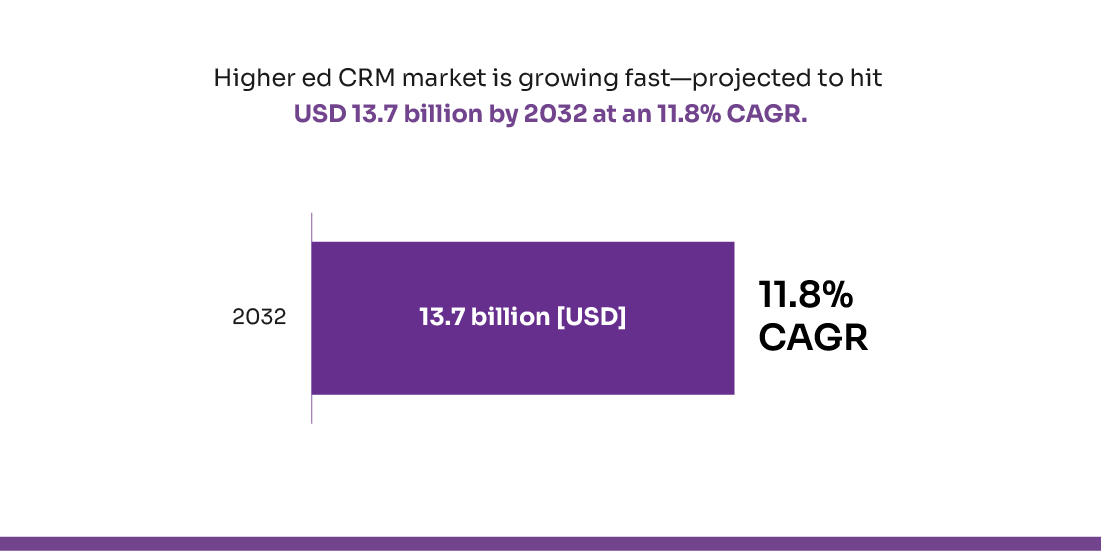
Choose a CRM that can adapt as your institution grows. While starter plans work well for smaller schools, the platform should allow easy upgrades to meet evolving needs. Flexibility is key to handling more students, programs, and data. Market research shows the higher ed CRM market is growing fast—projected to hit USD 13.7 billion by 2032 at an 11.8% CAGR. This highlights the rising need for scalable solutions.
Integration Capability: Will It Work Seamlessly with Existing Systems?
The CRM should integrate smoothly with your current tools, such as Canvas, Moodle, Blackboard, or other learning and administrative platforms. A connected system avoids data silos and promotes efficient collaboration across departments.
User-Friendliness: Is It Easy for Everyone to Use?
Salesforce offers an intuitive interface that’s easy to navigate—even for users with limited tech experience. In fact, 69% of students report improved experiences when institutions use tools that support personalized and user-friendly engagement.
Customization: Can It Be Tailored to Fit Your Institution’s Needs?
Each educational institution has its own way of operating, so the CRM must offer flexibility to customize workflows and communication. This ensures the system aligns with your specific goals and engagement strategies. Personalization is increasingly important in higher education. According to EAB’s 2024 survey, 93% of students prefer personalized messages when exploring colleges.
Security and Compliance: Does It Meet Data Protection Standards?
Protecting student and institutional data is a top priority, so the CRM must comply with standards like FERPA and GDPR. A secure platform should include encryption, access controls, and regular audits. Institutions that ignore cybersecurity risk major consequences. As per the National Cyber Security Centre, 60% of institutions without strong security measures have experienced data breaches.
Top Salesforce Education Apps to Improve Campus Operations
Salesforce AppExchange provides useful apps for schools and universities that help streamline admissions, advising, alumni relations, and fundraising—making daily tasks easier and more efficient.
Enrollment Rx: Streamlined Admissions Management
Enrollment Rx simplifies the admissions process from application to decision. With tools for tracking application status, managing student inquiries, and automating workflows, institutions can enhance student engagement from day one.
RIO Education: Complete Student Lifecycle Management
RIO Education is a student information system that helps institutions manage courses, schedules, and academic records. Built natively on Salesforce, it simplifies course planning, enrollment tracking, and student communications—all in one place.
Affinaquest Advancement RM™: Strengthen Alumni Engagement & Fundraising
This application helps institutions boost alumni relations and fundraising efforts. With powerful tools for donor tracking, campaign management, and data analytics, Affinaquest helps institutions make strategic decisions that drive fundraising success and long-term alumni loyalty.
TargetX Recruitment Suite: Smarter Student Recruitment
TargetX provides ready-to-use tools for admissions and recruitment. With over 20 years of expertise, it helps institutions manage applicant pipelines, personalize outreach, and improve admissions efficiency through seamless Salesforce integration.
CoPilot by InsideTrack: Enhanced Student Advising and Retention
CoPilot is an all-in-one advising platform built for educational institutions and nonprofits. It consolidates student records, intervention plans, and engagement history, giving advisors the real-time insights they need to provide personalized support.
Overcoming Challenges in Salesforce CRM Implementation
Salesforce can revolutionize campus operations—but it’s not always smooth sailing. Here’s how schools can overcome common hurdles and make the most of their CRM investment.
Getting Everyone Comfortable with Change
Resistance to new technology is a natural reaction, especially when faculty, students, or staff are used to older systems.
Solutions:
- Role-Based Training Workshops: Tailor training sessions for different user groups (faculty, admin staff, IT, etc.) so each gets what’s relevant to them.
- Continuous Support System: Provide ongoing help through documentation, helpdesks, and regular Q&A sessions.
- Emphasize the Benefits: Clearly communicate how Salesforce reduces manual tasks and improves access to information.
Managing Data Integration & Quality
Integrating Salesforce with existing systems like SIS, LMS, or financial aid tools can be complex—especially if your data is inconsistent or outdated.
Solutions:
- Conduct a Pre-Migration Audit: Clean up your data before migrating. Eliminate duplicate, outdated, or irrelevant records.
- Establish Data Governance Policies: Define rules for data entry, updates, and ownership to maintain long-term data quality.
- Use Salesforce Integration Tools: Leverage Salesforce’s native tools and APIs to simplify integration with other systems.
Customizing Salesforce Without Overcomplicating It
Salesforce is highly customizable, but too much customization can make the system hard to manage and expensive to maintain.
Solutions:
- Prioritize High-Impact Customizations: Focus on changes that directly support your institutional goals.
- Use Built-In Features First: Start by exploring out-of-the-box tools and best practices. They often meet most needs without additional cost.
- Adopt a Phased Rollout: Implement Salesforce in smaller, manageable stages. This allows for testing and adjustments along the way.
Conclusion
Salesforce in the education industry is more than just a CRM—it’s a powerful platform driving smarter engagement, streamlined operations, and personalized learning experiences. From improving student retention to enhancing alumni relations, Salesforce empowers institutions to deliver lasting value at every stage of the student journey.


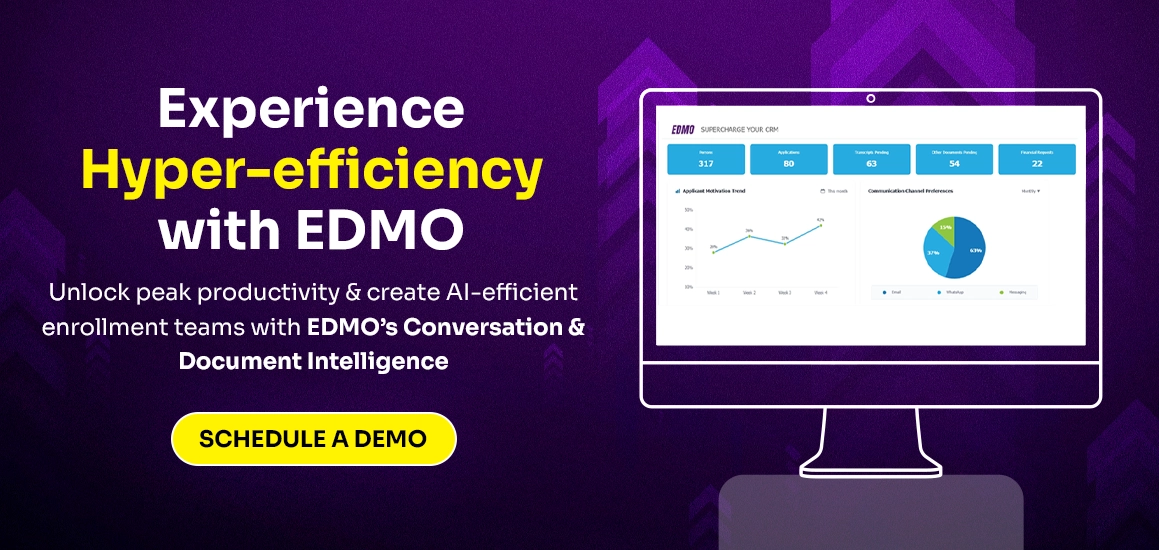



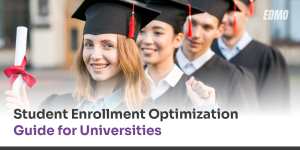
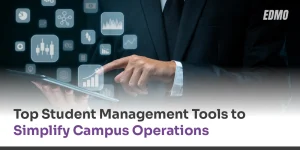
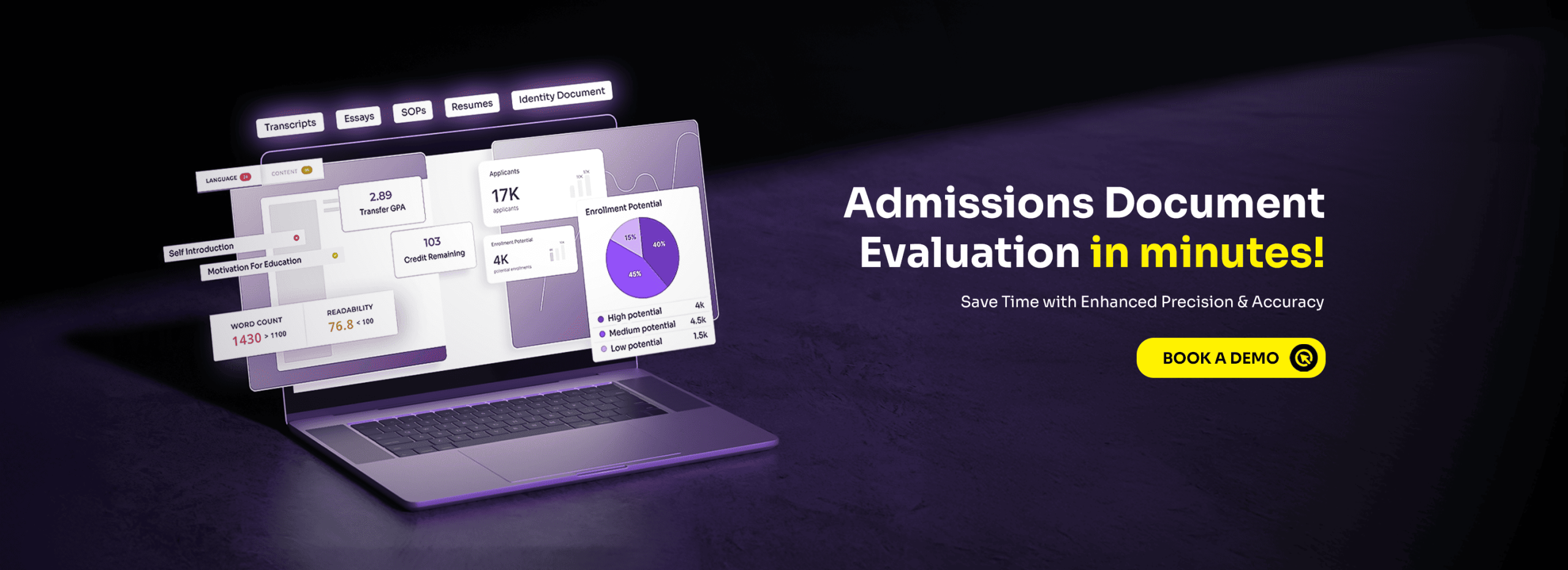

No comments yet. Be the first to comment!
Leave a Comment